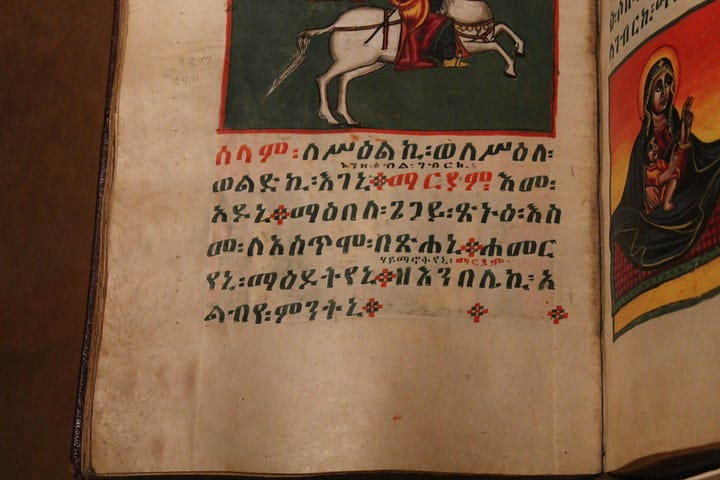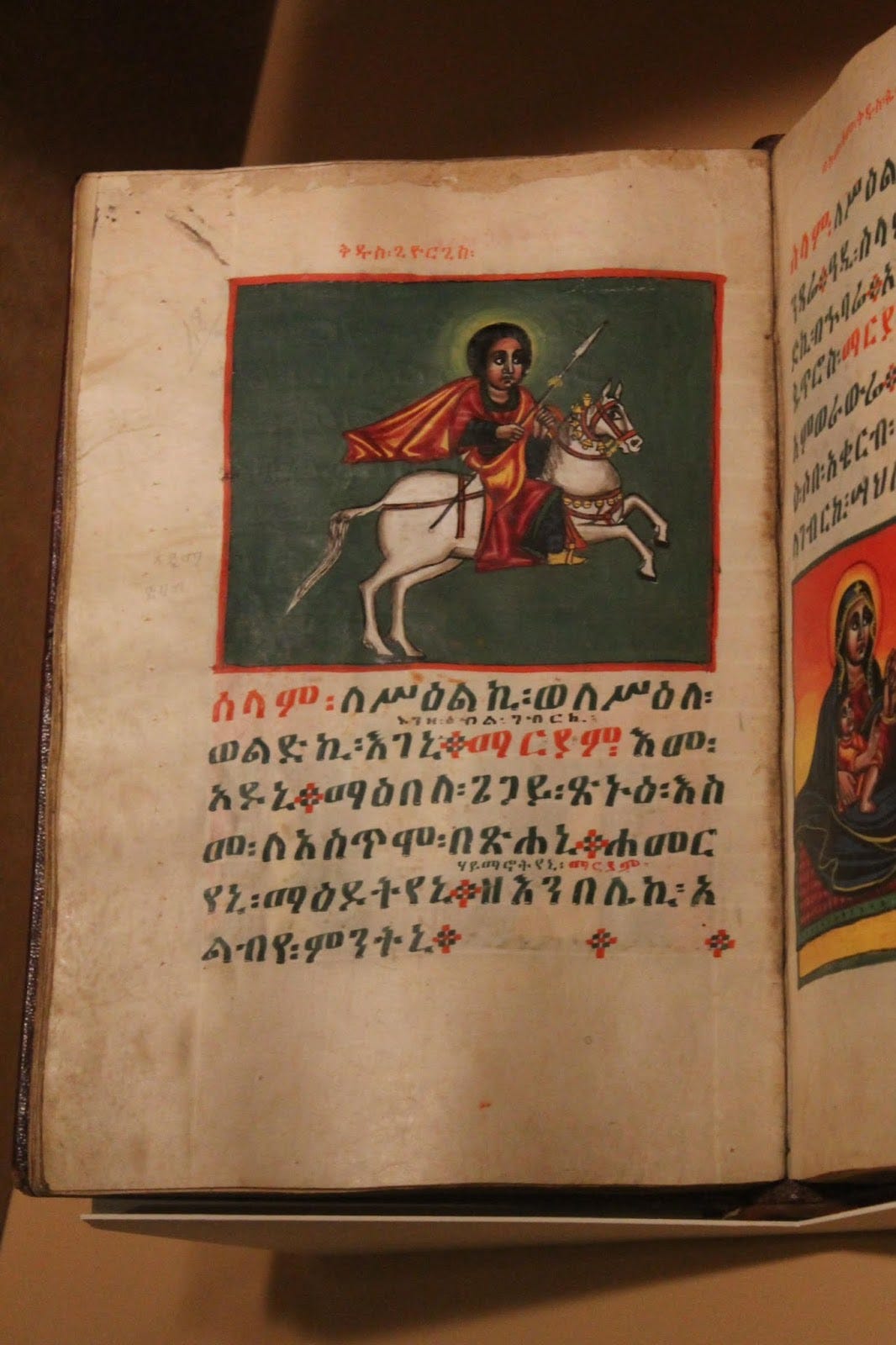One of the coolest things about learning ancient languages, you have access to a wealth of documents that have never been translated.
There are even countless Greek manuscripts (ms) of Church Fathers and Mothers that have never been put into English.
What I am presenting today are two pages from a codex that I translated—with help from my professor, Dr. Dewrell—while learning Ge’ez. If you do not know what Ge’ez is, it is classical Ethiopic, and it was the liturgical language of the Ethiopian Orthodox Church.
Unfortunately, I have little information about the actual codex (book) because I was not part of the class that was studying Ethiopian Church history—it is 119 vellum pages with 109 illustrations. Dr. Dewrell and I were invited on this field trip to the Princeton University library because the other professor knew we were doing an independent study on Ge’ez.
You may think, why was a NT guy learning Ge’ez, a semitic language? Well, from my senior thesis, I wanted to analyze a passage from Jubilees, which is only preserved in Ge’ez, so I took a semester to learn the language.
Interestingly, checking my emails, we went on this field trip 15 October 2014. How fitting for me to think of it randomly today and decide to post this.
--
I have provided my smoothed out translations that I created—there are plenty of errors, I’m sure; I had only been studying the language a couple months.
But, in the following article, I will also supply Dr. Dewrell’s translation, then my rough translation with notes that I did based on his, and finally his response to my translation to illustrate how one might go about translating a newly discovered text.
Enjoy:
Smoothed Out Translations (Speculative):
Caption: Saint George
Peace to your image and to the image of your son ’egani (?). Mary, mother of God. The wave of sin (is) severe, indeed, for (it) submerges; (the wave) befalls me. (You are) my very ship, my very ferry boat. Except for you, I have nothing.
Caption: How Saint Peter Stood Before Mary
Peace to your image, which is pleasing in appearance. Furthermore, peace also to your son for the feast of St. George & Mary (?). The crown of Peter’s office (is) Mary, who shines more than topaz. For your beneficial miracles, I celebrate the Eucharist/offer songs. Cover your servant (with) your merciful robe.
Dr. Dewrell’s First Draft
(Caption): Saint George
Peace to your image and to the image of your son ’egani (proper name of some kind?)• [between the lines: while ‘ebel(?) your doing)] • Mary mother of God [lit. ‘adoni “my lord” (in Hebrew!)] • The strong wave of sin strong, indeed for submerging, befalls me. • [between the lines: my very faith Mary]. My very ship, my very ferry, • which, except for you, I do not have anything.
(Caption): How Saint Peter Stood Before Mary
Peace to your image which is pleasing in its appearance • Further, peace also to the the image of your son baxweb?r? (a personal name? “in” + a place name?) • Crown of Peter’s dignity/office/ordination, Mary you shine more than topaz. • To your effective miracles I will offer praises. • Protect me [margin: for me] by your making your mercy (into?) a robe.


My First Draft with Notes
Caption: Saint George
Peace to your image and to the image of your son ’egani.*1* Mary mother of Adoni.*2* The wave/flood of sin (is) severe/steadfast/strong, indeed, for (it) submerges;*3* (the wave/flood) befalls me. (You are?) my very ship,*4* my very ferry boat. Except for you, I have nothing.
Caption: How Saint Peter Stood Before Mary
Peace to your image, which is pleasing in appearance.*5* Further(more), peace also to your son for the feast(?) of St. George & Mary (baxwebārē).*6* The crown of Peter's consecration/office/rank/dignity (is) Mary, who*7* shines more than topaz. (With regard) to/for your (fem. sg.) beneficial/effective miracles I (will or habitual, so just the verb?) celebrate the Eucharist.*8* Protect/Cover your servant*9* (with?) your merciful robe.
Notes on Translations:
1. Leslau has nothing; I thought perhaps there could be a doubling with the n. Gnn means "become important, be proud." gǝnun (Gr) means "notable, person of note," but this seems to be of no use. It would make some sense to think that it could mean "my notable one," but the 'alf at the beginning renders this unlikely? The other problem is that "my" would be ya, not i as in Hebrew.
Who is being referenced? Are there saints, people, etc. associated with Saint George with a similar name?
Also, gānen (pl. ’agānǝnt) means "demon, ghost, evil spirit, devil, specter"; the morphology present does not allow such a reading. This would make some sense, though, since St. George is commonly depicted slaying a dragon, which represents Satan (devil) from Rev 12:9. This is also problematic since the beginning of the prayer is to praise those being referenced, so this is invalid.
Lastly, this could be a verb with a 1c. suffix (e.g. qatalani - "He killed me"). Problematically, I cannot find a verb that has only two radicals or a geminate.
2. Leslau: ኣዶናይ, "Name of God"—’adonāy, "God." It is interesting that this reflects the Hebrew for "my Lord." Why would the author choose to do this?
3. I cannot figure out the final vowel on this word (ō). This could be a 3rd masc. suffixed pronoun, so "for submerging him/someone(?)."
4. I'm a little confused by your translation "my very ship." Does the ni on the noun intensify the possession? I haven't run across this yet in my grammar.
5. I do not understand what is happening in this exceedingly long construction. Also, why are there two dashes below the mem? Is it just stylistic? I understand that the ze is "which"; ye'edem is imperfect (intensive?), "to be pleasing"; l is a preposition with neṣārē, "in appearance." Why is there a long e on the end of nṣr? Is this a common thing, not to have ":" separating each word? I was a little thrown off by this.
6. I couldn't find this either. The closest I found was: baxwbaxw a, "decay, become putrid, be worm-eaten, rot, stink, perish, be destroyed." Be destroyed makes some sense since it could be referencing the crucifixion, but the r is present, so I'm sure this is incorrect. For xabara, I found "maṣḥafa 'axbero, 'a homily for the feast of St. George and Mary'" (The first work comes from ṣḥf, to write; this form is related to a writing). There could be some association with "St. George and Mary" since both of their images are on the pages and there is no discernible reason why St. George is on the opposite page since there is no mention of him in the paragraph.
See Leslau p. 256, right column, just short of the middle of the page. My wild, unsubstantiated guess: peace also to your son in the Feast/Celebration of St. George and Mary." Again, a wild guess in the dark based upon shaky evidence.
As for a slight defense, the lack of aleph may not be problematic: broken plural? Why it's not present here... I have no answer. The verb, xbr, can mean to join, which is the only explanation I can give for why the two are combined into one homily/feast. How this developed, again, I have no answer, just speculation.
7. This can also serve as a relative pronoun; since there is a shewa, I am taking it this way. See Leslau, 33.
8. Verb: Imperfect intensive. Is this root related to Syriac? The liturgy of the Syrian Orthodox is known as the Qorbana, the Eucharist. Qarba can mean "to celebrate Mass, offer sacrifices." Could this also be a liturgical prayer?
9. Leslau shows that gabr, as here, means "servant." Can kdn take an object with la? You constructed this as an active participle, but the vowels don't match what I have found. Am I incorrect? This could also be substantiated by the marginal note?
Dr. Dewrell’s Comments on My Translation & Notes
I hit the same roadblocks you did. It almost means several things, but doesn’t precisely fit with anything that I could find.
What struck me as odd is that we get ‘adoni, not ‘adonay. That isn’t a major deal, at least in my opinion, but it is interesting that ‘adoni is a proper Hebrew form for “my lord” (‘adonay, the normal loan, is technically “my lords,” usually explained as a Hebrew plural of majesty).
-o marks the infinitive for the derived conjugations (cf. Lambdin p. 134). This has to be a CD form, which doesn’t appear in Leslau, but I felt comfortable making the guess that it means more or less the same as the CG form.
-ni can indeed be an emphatic suffix (cf. big Leslau p. 380b). I’m not 100% sure that’s what it is here, but it fits well enough.
I take the two dots under the m as the normal word divider that has been “tucked under” the m. A similar but less extreme thing has happened in the previous text under Mary’s name. I take zaye’ēddem as za, the relative pronoun, plus ye’ēddem D impf 3ms of ‘addama “to be agreeable pleasing” (cf. big Leslau p. 7). Thus, “which is pleasing.”
This remains an utter mystery to me. The fact that it appears in the exact same place as the problematic term you observe in note 1 makes me suspect that we’re dealing with a proper name of some sort. Maybe a place? Maybe the name of a holy day? Maybe the name of an individual? I currently have no solution.
Right you are. That’s definitely a relative pronoun, not a personal pronoun as I took it. (That’s what I get for relying on my memory when it comes to Ge’ez.)
This was the word that bothered me the most. I’m reading ‘aqēr(r)eb. That long e in the second syllable is a prime marker for a D or CD imperfect form, but the vowel in the first syllable ought to be e (D) or ā CD) not a. I couldn’t come to any good conclusion, but we do have an object (which I don’t see in your translation) zemārē “psalm/singing of Psalms/hymn/collection of Hymns” (cf. big Leslau 639). Although qrb can mean “to celebrate the Eucharist” it can also simply mean “to offer” in both the D and CD stems (big Leslau p. 440). Thus I went with “I will offer song(s).” (I’m still not at all comfortable with that initial a vowel, though.)
Spot on. I didn’t like the verbal noun I went with at all, but I missed gabr servant. Your reading is clearly the correct one.
If you wish to keep reading about the New Testament and the Early Church, would you kindly subscribe?






